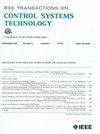增强基于能量反射的时域无源方法的力透明度
IF 3.9
2区 计算机科学
Q1 AUTOMATION & CONTROL SYSTEMS
引用次数: 0
摘要
时域无源方法(TDPA)被开发并应用于解决机器人应用中的各种控制挑战,如非配位力传感、权限缩放或延迟耦合。针对延迟问题,最近提出了基于能量反射的TDPA (TDPA- er)来改善位置跟踪和力反馈质量。与传统的TDPA相比,TDPA- er本质上防止了位置漂移,从而大大提高了耦合刚度。在这里,我们扩展了TDPA-ER,以进一步增强操作员在远程操作场景中感知的力透明度。该扩展基于两种独立的控制策略,其中包括重组TDPA-ER的能量分布,并通过偏转域无源方法(DDPA)确保更连续的力分布。实验证实,TDPA-ER改进了力反馈质量和力的连续性。此外,研究表明,所提出的遥操作控制策略可以鲁棒地处理与动态对象和活动环境的交互。本文章由计算机程序翻译,如有差异,请以英文原文为准。
Enhancing the Force Transparency of the Energy-Reflection-Based Time-Domain Passivity Approach
The time-domain passivity approach (TDPA) was developed and applied to tackle a variety of control challenges such as noncollocated force sensing, authority scaling, or delayed coupling in robotic applications. Specifically for delay, recently, the energy-reflection-based TDPA (TDPA-ER) was proposed to improve position tracking and force-feedback quality. In contrast to the conventional TDPA, the TDPA-ER intrinsically prevents position drift, thus substantially increasing the coupling rigidity. Here, we extend the TDPA-ER to further enhance the force transparency perceived by the operator in teleoperation scenarios. The extension is based on two independent control strategies that, among others, reorganize the energy distribution of TDPA-ER and ensure more continuous force profiles through the deflection-domain passivity approach (DDPA). Experiments confirm the improvement of force-feedback quality and force continuity with regard to TDPA-ER. Furthermore, it is shown that interactions with dynamic objects and active environments can be handled robustly with the proposed teleoperation control strategies.
求助全文
通过发布文献求助,成功后即可免费获取论文全文。
去求助
来源期刊

IEEE Transactions on Control Systems Technology
工程技术-工程:电子与电气
CiteScore
10.70
自引率
2.10%
发文量
218
审稿时长
6.7 months
期刊介绍:
The IEEE Transactions on Control Systems Technology publishes high quality technical papers on technological advances in control engineering. The word technology is from the Greek technologia. The modern meaning is a scientific method to achieve a practical purpose. Control Systems Technology includes all aspects of control engineering needed to implement practical control systems, from analysis and design, through simulation and hardware. A primary purpose of the IEEE Transactions on Control Systems Technology is to have an archival publication which will bridge the gap between theory and practice. Papers are published in the IEEE Transactions on Control System Technology which disclose significant new knowledge, exploratory developments, or practical applications in all aspects of technology needed to implement control systems, from analysis and design through simulation, and hardware.
 求助内容:
求助内容: 应助结果提醒方式:
应助结果提醒方式:


